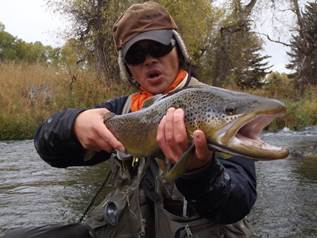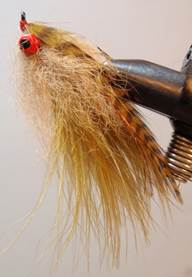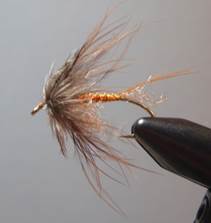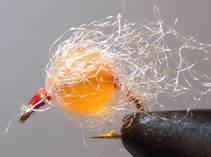LATE & EARLY SEASON FISHING AT DEPUY'S SPRING CREEK (part 4)
| Sysadmin Note |
|---|
| Part 3 can be found here |
PART 4: FALL ATTRACTION – 2
Time of Aggression: Although streamers and nymphs can always produce trout, fall is the glorious time to target the largest trout of the year with your favorite "meaty" patterns. Lots of large brown trout swim into DePuy's from the Yellowstone River for spawning, followed by rainbow trout (they enter the creek to munch on eggs but also some of them stay in the creek till their own spawning time). Sight is amazing. Trout population is as thick as aquarium all along the creek. Before I go on, here's a note to remember: When the BWO hatch is strong in the afternoon, as discussed in PART 3, even determined streamer/nymph fishers may consider matching the hatch. During those two hours trout seem to lose interests in large objects. Besides, I can't emphasize that several-pound class trout do rise for BWO dry-flies. Before and after that, one can enjoy heavy artillery to one's hearts content. This is just a suggestion to add varieties to your days.
Trout Behavior: Right after large brown trout enter the creek, they literally crash streamers and large soft-hackles passing in front of their face or territories. They need to accumulate some energy before spawning. That's where aggression on large flies comes from. This action typically goes on till early November. Once they are in spawning mode, they don't really chase streamers and large soft-hackles as ferociously as before. Instead they mostly bite on stuff coming toward their mouths. One can still present streamers and large soft-hackles slowly but nymphing is definitely more efficient. The number of rainbow trout increase as the fall goes by. They are either behind or among the browns' redds to devour eggs. But also they do bite on our streamers and large soft-hackles as browns do. Smaller individuals who don't look like spawners (residential or run-up) are also hanging around redds and can be taken by either method. Those are the ones I'd like to conduct stomach samplings on to observe what they are eating. Are they eating eggs as we guess? Yes, but oftentimes I find something very interesting to note.
Basic Tactics: Well-known fact – trout choose relatively shallow and moderately riffly area with pea-sized gravels on the bottom to make spawning beds. When one spots a few trout or group of them at those spots, experience will be very visible = sight-fishing. Streamers, large soft-hackles, or nymphs can be bounced right in front of them. As noted above, when large browns and rainbows are aggressive, streamers and large soft-hackles can be fished by swing, retrieve, twitch, or mix of them as in typical river tactics. Other structures to look for are deep holes and runs, which are numerous in DePuy's (distinctive features compared to other two creeks). Those are spots you'd better search and fish thoroughly. Nymphing with an indicator is certainly productive. Streamers need to be fished deep and retrieved or dead-drifted.
Flies: It's impossible to list entire rosters of effective patterns in this chapter. More detailed chapters that are dedicated for nymphing and streamers will follow. Showing here are my first arsenals of streamer, large soft-hackle, and eggs for the fall.
| McKnight's Home Invader | Yamamoto's Coyoted Pheasant | Otter's Egg |
|---|---|---|
|
|
|
|
|
|
Not only in the fall, but all through the year, I never visit spring creeks without this streamer by Doug McKnight (www.bigwaterstudio.com). Concoction of materials produces unbelievable "fishy" movement under water. |
My famous pattern is greatly accepted by fall- & spring-runners at DePuy's. One can swing, strip, twitch, or bounce it. It can be fished even under an indicator. |
Probably no other egg patterns can be as realistic as this one. Period. Egg materials needs super-glued and secured well with thread. One can enjoy catching frenzy till it's ruined or till one's inventory runs out. |

Note for Fishing Spawners:
There is nothing wrong for targeting spawning trout at DePuy's (NOTE: in spring some rules apply, which I will discuss in the future chapter).
As posters in each hut suggest, rules are: do not step on (or totally stay away from) redds, use 4X or heavier tippets, and bring trout quickly then release them accordingly. There are a couple of apparent spawning beds that attract most of anglers. I fish there once in a while, especially right after Winter Pass starts (prespawning mode). Then I would fish slightly below those areas for trout which are waiting for eggs washed away in front of them. I'm in no position to preach at other anglers about ethics and morals but I'd rather avoid trout that are actually making redds and mating. We are expecting them to produce the next generations so we can keep fishing. Besides, when one targets those trout who don't have much appetite (don't really care flies, that is), they often get snagged somewhere (bellies or fins) as heavy objects pass by. That makes landing them very hard and ends up exhausting the trout more than we are supposed to. Since I fish more than norm, I'd rather find and explore different spots. Then I am still able to find and catch some of largest trout in the creek.
| Sysadmin Note |
|---|
| Part 5 can be found here |



